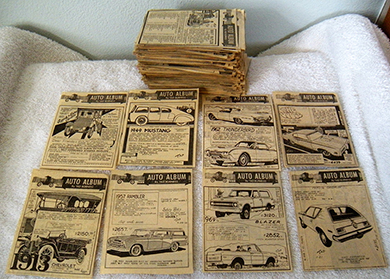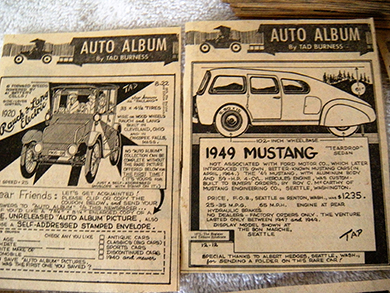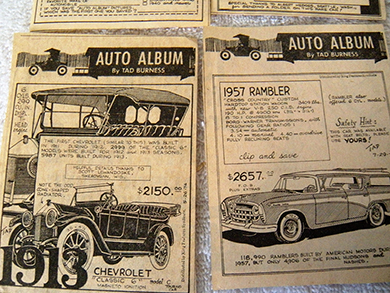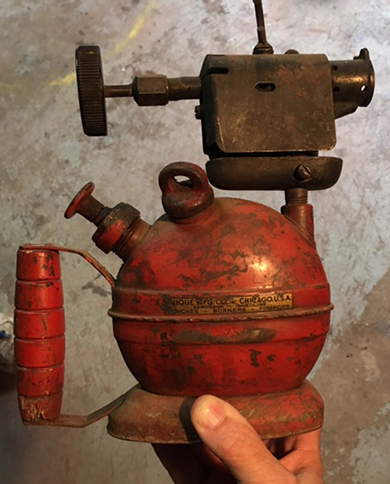 |
|
|||
 |
 |
|||
Copyright © Harry Rinker, LLC 2016 Questions
and Answers
QUESTION: I recently acquired between 550 and 600 clipped newspaper “Auto Album” cartoons drawn by Tad Burness. The cartoons date between 1967 and 1979. Each clipped cartoon measures 3 1/4 inches by 4 1/2 inches. King Features Syndicate distributed them on a weekly basis. It is a neat collection. What is it worth? – TB, Okauchee, WI, Email Question 
ANSWER: Tad Burness (July 11, 1933 to November 18, 2012) launched “Auto Album” on June 12, 1966. The cartoons featured information about a specific car model or series. The “Auto Album” cartoons were collected into four volumes, each available on the used book market. Burness also created a series of spotter’s guides that present one model year per manufacturer per page. Although detail is missing, the spotter’s guides allow quick make, model, and year designation. In addition, Burness authored “Cars of the Early ‘20s” (1968) and “Cars of the Early ‘30s” (1969). A resident of California’s Monterey Peninsula, he created “Pict-Tours” that highlighted local houses and their histories. 
Your stack of clippings was a labor of love by an automobile aficionado. In this instance, the labor of love does not create monetary value. WorthPoint.com lists a January 20, 2016 sale of a lot of 650 Tad Burness “Auto Album” clippings for $50.00, around $0.08 each. Examples of his “Auto Album” compilations titles sell between $10.00 and $15.00. While definitely neat, your collection of clippings has little value as a unit. It needs to be broken apart. The best method to maximize return on the collection is to organize the cartoons by manufacturer, attend an antique/classic car show or meet, walk the grounds, and offer the cartoon that pictures an owner’s car for $2.00. $2.00 should sell the clipped cartoon easily. $3.00 might work. $5.00 is pushy. If you sell 50 of the clipped cartoons at $2.00 each, you doubled the amount paid by the eBay buyer. I love neat things. Like “labor of love” collections, neat things usually are not about the money but the fact that the object or collection is neat. 
QUESTION: I have a lamp, the standard of which is a bronze cylinder mold for Luden’s Cough Drops. The cylinder is 12 inches high. The bronze standard weighs 73 pounds. The cylinder is drilled through the center to allow the cord to go from the base to the mantel. Can you provide any history about the lamp and its value? – P, Reading, PA ANSWER: In 1879, William H. Luden founded a firm that manufactured cough drops and candy. The success of Luden’s cough drops was ensured by a giveaway campaign to railroad workers who touted the cough drops to other railroad workers and passengers. Food Industries of Philadelphia, a holding company of the Dietrich family, acquired Luden’s in 1928. At its peak, Luden’s produced over 500 varieties of candy in addition to its famous cough drops. Hershey Foods Corp. bought Luden’s in 1986 and sold it in 2001 to Pharmacia. Pfizer acquired Pharmacia in 2003 and sold its consumer products division to Johnson & Johnson in 2006. Several additional brand ownership changes followed. In 2016, the Luden’s brand is part of Prestige Brands. [See: http://www2.readingeagle.com/article.aspx?id=54964] Luden’s was located in Reading, Pennsylvania. Unable to find any information about the lamp on the internet, I mentioned it during a WHATCHA GOT? broadcast. WEEU in Reading carries the first hour of the show. Joe, a former Luden’s employee, called and informed me the lamps were made in the 1970s. Lamps were made for the entrance, president, and three or four of the vice-presidents. In July 2016, the scrap market price for a pound of bronze is around $1.25. Based solely on weight, you lamp has a value of slightly over $90.00. Outside the greater Reading area, this may represent the lamp’s value. Its value to candy collectors is minimal. Cough drops are not candy. Inside the greater Reading area, the lamp’s value is between $150.00 and $200.00. At 73 pounds, it is not a neat thing. QUESTION: I purchased a blow touch. A decal label reads: “UNIQUE MFG. CO., INC CHICAGO USA / KEROSENE - GASOLINE / TORCHES – BURNERS – FIREPOTS.” The body is painted red. It shows clear signs of use. I date it mid-20th century. A friend was selling it. Although I felt it was worth $10.00, I paid him $20.00. I liked it. What are your thoughts? – KK, Email Question 
ANSWER: A blow torch is used to apply heat and flame while working with metals. A blow torch has a chamber that houses a liquid, either gasoline or kerosene. A hand pump allows pressure to be created inside the chamber. Most blow torches are hand-held. August von Marquardt invented the blow torch, known in Europe as a blow lamp, between 1797 and 1799. American blow torches had a distinctive flared base and used gasoline. Technical advances in blow technology during the Korean War made the hand-held blow torch obsolete by the 1970s. I was not able to find detailed information about the Unique Manufacturing Company. The company made a variety of products, such as camp stoves, in addition to blow torches. There were at least two types of blow torches, one with a flat side and a second with a round-ball shaped chamber. There are multiple for sale listings on the internet. The only dated example was listed as having been made in 1947. The asking price for examples in displayable but used condition range from $50.00 to $80.00. The top-end seems excessive. We agree on two things. First, the piece is neat. Its Art Deco shape allows it to serve as a fun conversation item in a living room or den. Second, I like it better at $10.00. It is not everyone’s taste, hence, a difficult sell. Yet, twenty dollars is a win-win price. You did not want to cheat your friend; and, your friend received more than he would from another buyer. QUESTION: I bought a No. 14 White meat cleaver at auction for $50.00. The blade is marked “L & I. J. WHITE / 1837 / BUFFALO, N.Y.” inside an eye-shaped oval. The blade is 14 inches long and 6 inches wide. The overall length of the cleaver is 30 inches. What can you tell me about the company and the market value of the cleaver? – D, Meyerstown, PA 
ANSWER: Brothers Leonard and Ichabod Jewett White moved from Buffalo, New York, to Monroe, Michigan to start an edge tool shop in 1837. The brothers sold their Michigan business in the early 1840s. By 1843, they were located in Black Rock, a Buffalo suburb. The company made a large assortment of edged tools, axes, and planes. By the time of the Civil War, the company was selling nationally. In 1859, “Butchers’ Cleavers and Knives” were included in a listing of the firm’s products. An 1867 fire destroyed the factory. By 1870, White was back in business with a new factory located at 132 Exchange Street, Buffalo. The firm incorporated as “L. & I. J. White” in 1882. The company showcased its products at the 1889 Paris Exhibition, 1902 Pan American Exposition, and the 1904 St. Louis Exposition. By this time, L. & I. J. White products were selling worldwide. An early 20th century product list includes “cleavers.” A 1905 catalog identifies the shape as a “Pork Cleaver.” L. & I. J. White became part of Simonds, Worden, White Company of Dayton, Ohio, in 1928. Production shifted more toward industrial tools. The Buffalo plant closed in 1940. Given the above, it would be easy to assume your White cleaver was made in the 19th century. I favor an early 20th century date. The “No.” refers to the length of the blade. The cleaver most likely was used in a meat processing plant as opposed to use by a local butcher. The $50.00 you paid is a bargain. I found several listings, each with a value around $175.00. [See: http://www.bladeforums.com/forums/showthread.php/1081735-Antique-L-amp-I-J-White-Beef-Splitter-Cleaver-thoughts] Be careful how you use or display it. It is one intimidating tool. Harry L. Rinker welcomes questions from readers about
collectibles, those mass-produced items from the twentieth and twenty-first centuries.
Selected letters will be answered in this column.
Harry cannot provide personal answers.
Photos and other material submitted cannot be
returned.
Send your questions to: Rinker on Collectibles, 5955 Mill
Point Court SE, Kentwood, MI 49512.
You also can e-mail your questions to
harrylrinker@aol.com.
Only e-mails containing a full name and mailing address
will be considered.
You can listen
and participate in
WHATCHA GOT?, Harry’s
antiques and collectibles radio call-in show, on Sunday mornings between 8:00 AM
and 10:00 AM Eastern Time.
If you
cannot find it on a station in your area,
WHATCHA GOT?
streams live on the Internet at www.gcnlive.com.
SELL, KEEP OR TOSS?: HOW TO DOWNSIZE A HOME,
SETTLE AN ESTATE, AND APPRAISE PERSONAL PROPERTY
(House of Collectibles, an imprint of Random House Information Group, $17.99),
Harry’s latest book, is available at your favorite bookstore and via
www.harryrinker.com.
|
||||